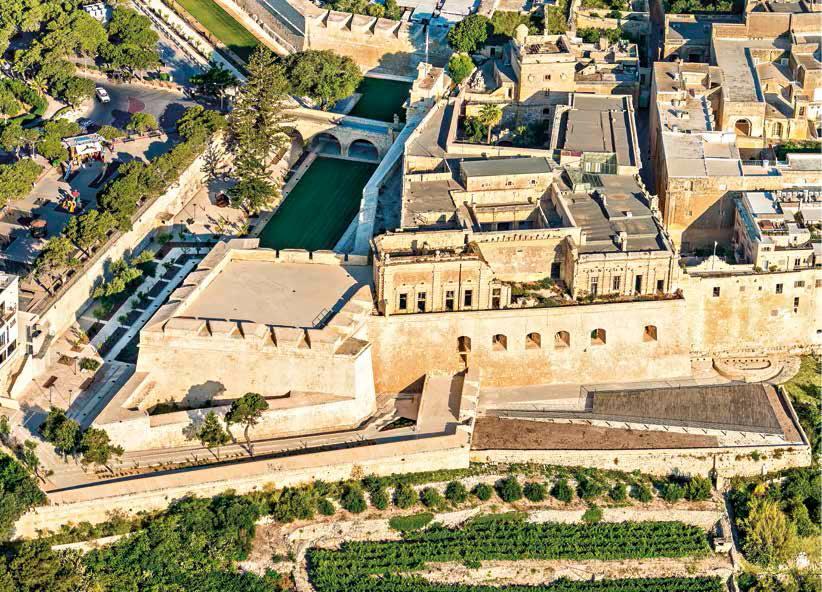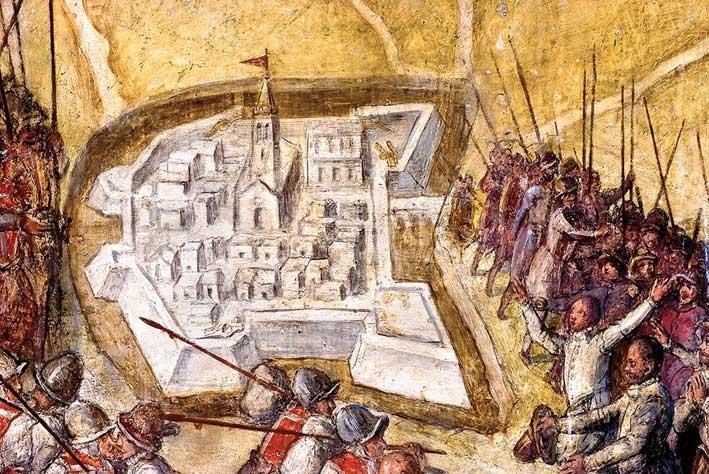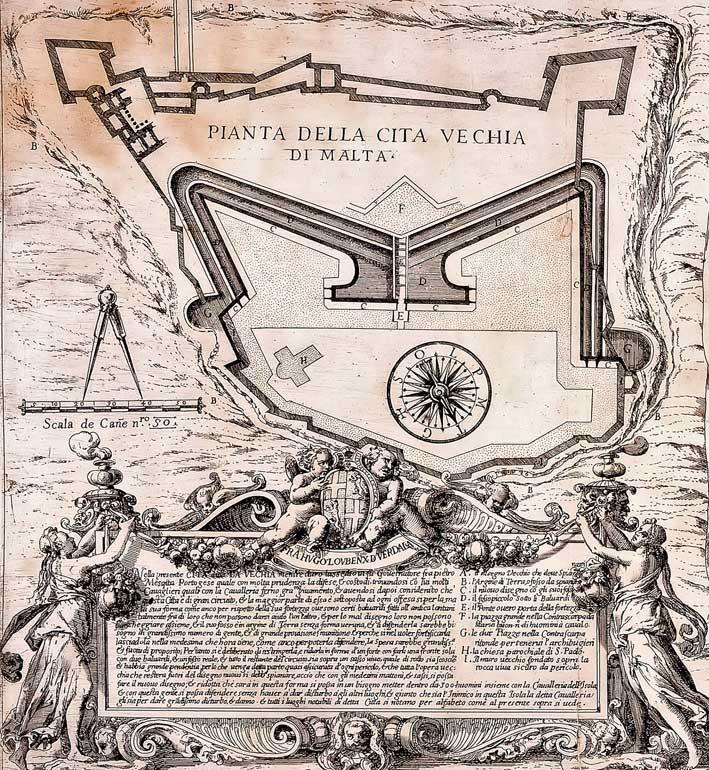Mdina, Malta's old capital, has been besieged many times in the past but it was only defeated twice - the latest being in 1798, by the Maltese.
This was the contention of well-known photographer Daniel Cilia, who gave a talk on the subject at Marsa Sports Club last Wednesday.
Many of Mdina's earlier sieges are lost in antiquity and details are sketchy. The first instance must have been in prehistoric times. Those who walk around the newly-restored Mdina ditch can see carved in the side walls the remains of silo pits which must have been used to store grain, not water, in the Bronze Age.
The recent restorations in the area have yielded many archaeological remains which are still being studied so no conclusions have yet been reached.

Aerial photo of D'Homedes Bastion 1551
In around 700BC, the Phoenicians came to Malta. They were not warriors but traders and must have appreciated Malta for its safe harbours. Temi Zammit found an oriental looking, most probably Punic, limestone head in a Roman well close to the Domus.
The Phoenicians later founded Carthage in Tunis and Malta fell to the Romans in the Punic Wars.
The Romans called Mdina 'Melita' and the town was far larger than it is today. Back then it extended from today's Mdina on one side to St Paul's Grotto on the other. In fact, the remains of the ditch on that side is still visible outside St Paul's church and it continued in the wide road that has now been created in front of the church.
With the breakdown of the Roman Empire, Malta formed part of the Byzantine world but was used mostly as a place to which political prisoners could be exiled. By the time of the Byzantines Mdina was reduced to its present dimensions. Most probably they also strengthened the bastions, creating the round tower one can still see facing Mtarfa.

The people of Mdina welcome the arrival of the soldiers of the Gran Soccorso. Detail D'Aleccio painting at the the GM Palace, Valletta
In 870AD, the Muslim Arabs from North Africa, who had attacked Sicily from the north, slowly overcame Sicily and then conquered Malta. Mdina was attacked and taken and the rest of Malta followed.
In 1090, the Normans attacked southern Italy and later Sicily and finally Malta. No fight ensued and Mdina's gates were opened to the invaders. Most probably no fight ensued and Mdina's gates were opened to the invaders.
The first recorded siege of Mdina took placed in 1429 and it can be considered as greater than the Great Siege of 1565.
At that time, North Africa had been taken over by the Sunni Muslims called Hafsidi who wanted to re-occupy Sicily. Malta, being in the middle, was attacked first.
At that time, Malta's population consisted of some 5,000 to 6,000 people and the invading army had some 18,000 fighters. Malta had no foreign soldiers to help defend it, as it had in 1565, but Mdina was well-prepared for such a siege.
There is a story that the invading troops placed bread at the entrance to the city to taunt the defenders that the invaders had bread while the Maltese did not. But during the night, the Maltese crept out of the city and placed ġbejniet on top of the bread to show they had not just bread but also ġbejniet.
This siege is also renowned for the religious legends surrounding it. Originally, the legend said St Paul, sword in hand, appeared defending the city. Mattia Preti later painted the scene for Mdina Cathedral but he depicted the Hafsidi as Ottoman Turks.

The Despuig Bastion sally port used by the Maltese to enter Mdina during the French Occupation.
A far more recent depiction is in St George's Basilica in Gozo which has not just St Paul but also St Agatha and St George appearing to defend the Maltese.
Nothing is known about the 1429 siege except that at some point the invaders must have given up and left.
The next siege of Mdina took place in 1551, the one known for the sacking of Gozo. Earlier, the knights and Andrea Doria had attacked Dragut's well-fortified town of Mahdia, outside Tunis, and destroyed it.
In retaliation, Dragut, who had also lost a brother during a previous raid on Gozo, vowed vengeance. His force landed in Marsamxett but found Birgu too well-fortified to be attacked, so then tried to attack Mdina, but found that too well-fortified too. So they moved to Gozo, attacked and overcame the Cittadella and murdered or took the Gozitans into slavery.
One of the main streets of Mdina is Villegaignon Street and it is named after the knight who strengthened the Mdina defences during the 1551 siege.
Even in this siege, there are legends of supernatural help. It is said that St Agatha appeared on the bastions to encourage the Maltese and in fact every year, on her feast day, a procession is held from Mdina Cathedral to Rabat, Malta.
The 1565 Great Siege of Malta is justly honoured - not just by Malta but by the rest of Europe. Although the fighting took place mostly around Birgu and Mount Sciberras (today's Valletta), Mdina too had its share. Had it not been for Mdina, Malta would have lost the siege.
After the 1551 siege, Grand Master D'Homedes strengthened the bastions, adding the two known as the D'Homedes and the St Peter bastions, the first two bastions built by the knights in Mdina.
The huge Turkish armada touched land at Ghajn Tuffieha intending to attack Mdina but then moved to Marsaxlokk Bay for better fleet security. Turkish general Kızılahmedli Mustafa Pasha insisted on wanting to attack Mdina first in order to cut off any possible communication from Sicily but he was overruled since admiral Piali wanted to attack Fort St Elmo so that the Turkish fleet could use Marsamxett Harbour for mooring. This was a miscalculation that was to them cost the siege.
The attack on St Elmo began, and the Maltese massed behind the walls in Mdina could only watch in impotent anger. St Elmo fell on 23 June.
Some days later, Mustafa sent Suleiman the Magnificent a parchment map showing the Turkish flag flying on St Elmo and Mdina still flying the flag of the Order.
On 7 August, the Turks attacked Birgu and Senglea in full force. That is when the pent-up fury of the people locked inside Mdina erupted: the entire Knights' calvary housed there, emerged from Mdina and swept to Marsa, killing any Turks they found, wrecking the Turkish camp at Marsa and causing mayhem in general. The Turks thought that the expected help had arrived from Sicily and desisted in their attack on Birgu, which had been, by then, almost succeeded.

After the Great Siege of 1565 there were plans to turn Mdina into a fortress, reducing its size to nearly half of that of today.
The first help from Sicily soon arrived. Known as the Piccolo Soccorso, the force landed at Gnejna and marched to Mdina. Then it passed on in great silence to Ricasoli where it was ferried to Birgu by innumerable boats belonging to the Maltese.
More knights and soldiers who wanted to come and help in the defence of Malta kept massing in Messina. This is the famous Gran Soccorso. It left Messina on 21 August, arrived in Syracuse the next day and left on 25 August. But it was caught in a fierce storm and sought shelter on the west coast of Sicily. On 1 September it went to Linosa, but a new storm blew up and the fleet had to return to Sicily.
On 6 September, it arrived at Ghajn Tuffieha and Mellieha. It consisted of about 8,000 soldiers and knights but the Turks thought it numbered some 16,000. Mustafa gave up and ordered the end of the siege.
The Turks embarked on their ships and were leaving when Mustafa realised his mistake and ordered his troops back on land. That is where the Maltese, the knights and the Gran Soccorso came into their own. They issued forth from Mdina and, with their fresh forces, attacked the Turks around St Paul's Bay and Salina. It is said that so many Turks were killed that Salina could not be used for months afterwards due to the number of bodies.
But the danger for Mdina did not disappear after the Great Siege. Glormu Cassar, the Maltese architect, drew up a plan for a vastly re-dimensioned Mdina, which would be just a fortress around half of today's Mdina. But the old noble families of Mdina objected and the plan was not implemented.
The last siege of Mdina took place in 1798 when the Maltese rose against the French, who retreated to Mdina. But the Maltese knew their Mdina better than the French and entered the city through a sally port at the back of the cathedral, next to the De Piro palace, and took over the city from the French who were then expelled.
In World War II, Mdina was not attacked, although people there had a grandstand view of the constant bombing on Ta' Qali just outside it.
The lecture was part of a chain of lectures done by author Vincent Zammit and photographer Daniel Cilia in connection with the series of books, The Cultural Legacy of Malta & Gozo books published by The Salesians of Don Bosco (Malta) and edited by Fr. Charles Cini SDB. Three books have been already published; The Village Feast, The Neolithic Temples and Mdina, Città Notabile.